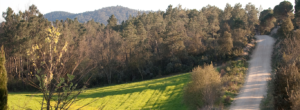Ruta Patrimonial
Sant Grau Hill
1st – 19th centuries. Small promontory in Caldes where there are several thermal water springs, which since olden times have been exploited through the construction of Roman thermal baths. In Medieval times, the hill was occupied by Caldes Castle; today, only part of the wall and the towers remain.
Sant Grau Chapel (9th century), which gives its name to the site, was the town’s parish church until it become obsolete due to the growth of the town and the fact that it was built in a zone with strong upwellings of thermal water, since it caused the bodies in the cemetery not to decompose, but rather mummify. So, it was decided to construct outside the walls the new St. Stephen Church (11th century). From this point, Sant Grau Chapel was the place where the townspeople gathered: the town meeting, etc
In the 19th century, the industrial company Pau Estapé i Maristany acquired a large part of the land and constructed the “Imperial Water” bottling plant on today’s plaza del Agua. Making the most of the high numbers of summer holiday makers at Caldes municipal thermal spa, Mr. Estapé adapted the space to develop its product. In addition to carrying out the first archaeological excavation campaign of the Roman thermal baths, a Modernist garden was created that incorporated the Sant Grau or La Roqueta and the Hospital hot spring sources on Neoclassical style platforms. With the crisis of the summer holiday phenomenon, the entire complex continued to deteriorate to an advanced degree until Caldes Town Hall bought it and renovated it a few years ago.






 By bike: 30 minutes
By bike: 30 minutes 5,3 miles
5,3 miles

